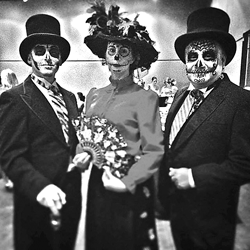Dia de los Muertos: A CELEBRATION OF THE SOUL – Around The Frame
 Recently many youngsters and oldsters alike celebrated Halloween by trick-or-treating/trunking and partying. Halloween is an abbreviation of All Hallow’s Evening for the next day, November first, is All Saints Day when hallowed saints, martyrs and the faithfully departed are remembered followed by November second, All Souls Day, a time when people often visit cemeteries to remember the special people in their lives and for Catholics to pray for the souls in purgatory. These three days form a triduum similar to the Paschal Triduum of Holy (Maundy) Thursday, Good Friday and Easter. It is interesting to note these two triduums share a life-death-life cycle and are observed in opposite months of the year. Countries and cultures around the world venerate their dead generally in November when cyclically the world is dying after the crops are harvested and the ground is bare.
Recently many youngsters and oldsters alike celebrated Halloween by trick-or-treating/trunking and partying. Halloween is an abbreviation of All Hallow’s Evening for the next day, November first, is All Saints Day when hallowed saints, martyrs and the faithfully departed are remembered followed by November second, All Souls Day, a time when people often visit cemeteries to remember the special people in their lives and for Catholics to pray for the souls in purgatory. These three days form a triduum similar to the Paschal Triduum of Holy (Maundy) Thursday, Good Friday and Easter. It is interesting to note these two triduums share a life-death-life cycle and are observed in opposite months of the year. Countries and cultures around the world venerate their dead generally in November when cyclically the world is dying after the crops are harvested and the ground is bare.
For the last few years the Fort Wayne Museum of Art (FWMoA) has hosted Dia de los Muertos, the Day of the Dead celebration of Mexico. This celebration’s roots are very deep. Its history goes back 4000 years, thousands of years before the country of Mexico existed. After the Spaniards conquered the Aztecs in 1521 they tried to force them to adopt Catholic beliefs as they considered their belief system to be barbaric. As often happens when one group tries to impose their beliefs on another, yet living in close proximity the Aztecs did not give up their beliefs but over time incorporated some Catholic rituals including corresponding their honoring of the dead with the Catholic dates of Nov. 1-2.
How one culture group influences another can also be observed in how Dia de los Muertos is traditionally celebrated in Mexico as opposed to now in the United States.
In Mexico families traditionally go to the cemetery to clean and decorate the graves of family and friends leaving behind offerings of water, food and flowers. They bring their instruments and boom boxes to serenade the departed with their favorite music. They create altars in their homes over the days preceding the Feast Day decorating them with marigolds, candles, photos and favorite items to please and pay homage to the soul.
Mexican artist Jose Guadalupe Posada’s (1852-1913) artwork is linked to Dia de los Muertos. Posada used satire when he created the etchings Calavera de la Catrina (Skull of the Madame) with her large chapeau in the fashion of upper crust Frenchwomen and Calavera del Catrin (Skull of the Dandy) her male counterpart with top hat and long coat. It was Posada’s sly way of poking fun at native Mexicans who wanted to emulate the fashions, manners and traditions of the French aristocracy during the decades-long presidency of President Porfirio Diaz.
Here in Fort Wayne Palermo Galindo, President of the Great Fort Wayne Chamber of Commerce met with school groups to teach them the Dia de los Muertos traditions. One student wanted to make an altar to celebrate the souls of three family members dividing the altar space equally between the three. Palermo explained the altar space must not be compartmentalized. In the US the individual is valued over the group, but in Mexico it is the group that dominates, therefore the items for all three must be intermingled-much like their real life relationships.
In the United States there is the tradition of wearing costumes on Halloween. This is not a part of the traditional simple Mexican observance. Again as two cultures intermingle, customs and rituals evolve and today Mexicans may dress up in costume, most likely one featuring a skull and may attend festivities including music and dancing: A nod toward the living as well as the soul. After all: life is for the living so why not celebrate life knowing sooner or later, death comes to us all!
For information on creating an altar contact Palermo Galindo at bit.ly/1zmw5Fr
Lois Levihn is the owner of Born Again Quilts restoration studio and quilt gallery.
Located at 4005 South Wayne Ave it is open 5:30-7 p.m. T-W-TH and 9-2 p.m. on Saturdays or by appointment.
- The Stars & Stripes Are Forever: Around The Frame - July 5, 2024
- Sam Butcher: A Life Filled With Precious Moments ~ Around The Frame - June 7, 2024
- Aunt Dora & Her Well-Lived Life ~ Around The Frame - May 10, 2024


